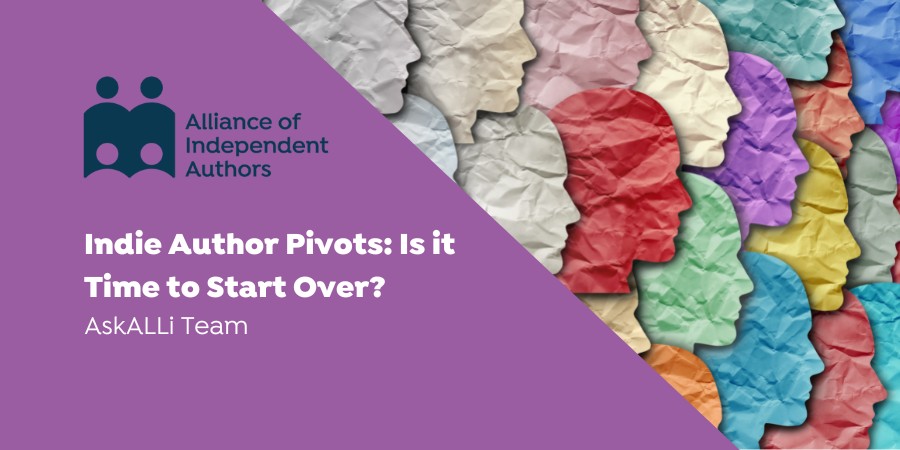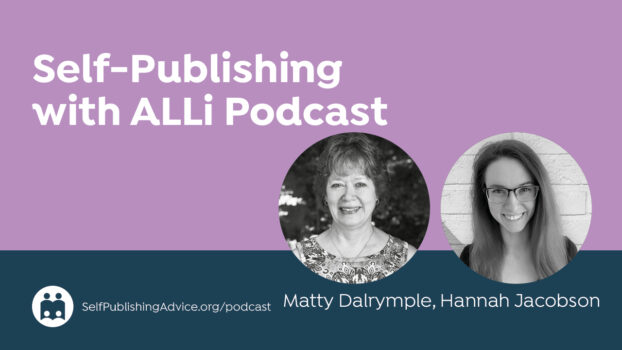In every indie author's life comes the time when you need to change what you've been doing, or how you do it. Today, the Alliance of Independent Authors AskALLi team is talking about starting over with covers, distribution outlets, brand names, and other indie author pivots.
One of the best things about being an indie author is that you can always start again. You can fix up old books that are less than your best but equally significantly, you can make a drastic change–a creative pivot–and start again from scratch.
Book markets are in constant flux. New authors coming into our genre and nice all the time, doing new things. New trends emerge or old ones are given a new twist. Billionaire romance, vampire fiction, space opera are three examples in recent years. With every trend, every new cycle, we have an opportunity to try something new or start again.
Authors do smaller break outs and build new audiences all the time:
- Finding a new content marketing niche that clicks and builds audiences
- Using a new social media platform (looking at you, BookTok)
- Experimenting with a new advertising method
- Spotting an underserved niche and adapting accordingly
The list goes on. And then there are most drastic pivots, which we explore below. The point, though, is that you can always start over, but you'll do best when you absorb the lessons you've learned to date, and turn them into a cogent plan.

Sacha Black, Author and ALLi Blog Manager
Indie Author Pivots: Sacha Black on Starting A New Brand Name
While I have an established nonfiction brand under the Sacha Black name, I wanted to develop a new fiction brand that would be sustainable in terms of income and that I would find fun to write.
I came to writing as escapism from the day job and somewhere along the line, I'd lost a bit of that sparkle by turning it into a job. Novelists make up stuff and tell lies that look like truth for a living. What's more fun than that?
So when it came to making this pivot, my goal was threefold: find a genre that was fun to write; write books readers wouldn't be able to put down; make enough money to show that this could be the start of a sustainable fiction brand for me.
Preparing to Pivot
I knew I wanted to find a market that had both commercial and creative potential, so I started with the market. I chose sapphic fantasy romance and I did all of the following marketing tasks before I wrote a word of the books.
- I bought and read one of Alex Newton's K-Lytics reports, specifically on the fantasy romance market
- I read many, many books, both those that were fantasy romance and also others that were sapphic.
- I knew I wanted to begin with KU for this series, as I publish everything else wide so I spent a considerable amount of time researching Amazon. I mean weeks closely examining what was trending on the store, not just an afternoon here or there.
- I picked out common tropes I found, as well as book lengths, styles of writing, pace, the amount of snark and other patterns in the writing
- I studied common brand colours and book cover patterns
- I read the reviews of lots of comparable (comp) titles to see what readers liked and didn't like overall in the genre
- I collected a large quantity of comp books and authors—categorising them under various headings by various factors
Building Indie Author Business Infrastructure
- The Ultimate Guide to Email Marketing for Authors 1: Mailing List Strategy
- 2. Growing Your Reader Email List(s)
- 3. Maintaining your Reader Email List
I followed this advice closely.
Platforms + Marketing
I'd already decided I didn't want to have to manage multiple social media platforms and create content for them all. So I went with TikTok. One, because I don't mind being on camera, and two because it's the most LGBTQ+ friendly of all the platforms.
I posted on TikTok daily, using trending sounds, and tried to link the content to my book, though I also tried to have content that wasn't book related too. After three weeks of posting at least once a day, commenting on other TikToker's posts and replying to comments on my own posts, I hit 1000 followers and was able to get a link in my profile.
 What I saw was a huge surge in physical paper and hardback preorders. So much so, that by the time launch day arrived, 58% of preorder and launch day sales were paperbacks.
What I saw was a huge surge in physical paper and hardback preorders. So much so, that by the time launch day arrived, 58% of preorder and launch day sales were paperbacks.
This is a very different trend than what I've typically seen before. While I can sell up to 30% of orders as paperbacks for my nonfiction, I'm told even that is high when looking at the patterns across most indie authors.
I paid for a book tour on Instagram that lasted a week. There were issues with the UK postal system, which made getting physical copies to book reviewers very tricky. So I sent digital ones, this did lower the quality of the social photos though.
I used tropes in the marketing both in post images and also in videos and blurbs. This made it considerably easier to point at a trope and say “this is what the book is about”. Reader's get tropes. They're quick, hooky and catnip. Don't be afraid to use them to help explain and market your books.
Other Marketing Aspects
I spent a considerable amount of time pitching for reviewers. This was an uphill slog as a new author with no credentials to show. It was one of the most time-consuming aspects, but I did end up with some. The book tour helped a little too. ALLi has a guide on how to get your first 50 reviews, which you can find in our bookstore or access for free if you're a member.
I ran a pre-order incentive for anyone who pre-ordered the book, regardless of format. All they had to do was send pre-order proof to a dedicated email address. This had an autoresponder set up so the goodies were sent automatically, reducing my workload.
The pre-order incentive included:
- a sneak peek at chapters 1-3
- the ability to sign up for the prequel
- entry into a giveaway to receive a signed
- personalised hardback, stickers, bookmarks,
- a Chance coin featured in the book itself
- access to the playlist I listened to while writing
- a Pinterest mood board for the book.
I saw an immediate increase in pre-orders every time I promoted this incentive, which I did through graphics on Instagram, in my mailing list and through a couple of videos on TikTok.
It goes without saying, but I made sure the book cover was as to-market as possible. I also hunted for genre-specific Facebook groups and review platforms.
Conclusions
If you'd like more detail about what I did, I highly recommend the podcast episode/blog post I wrote. But in terms of spend, I spent £814 getting the book to publication. This includes the cover, edits, book tour and any marketing spend up until I started running AMS ads.
By the end of launch day, I'd already made it into the black. Between Amazon and the physical preorders on Ingram Spark, I made more than £814 I'd spent. The book launched on February 10th and as of the 19th, it's still holding its rank in the US between 5290 and 8500. And a similar ranking in the UK. While ranks are not always indicative of income, it is indicative of the fact it is still earning. Not enough to pay off a mortgage anytime soon. But certainly enough to show considerable potential for the rest of the series. If I have five books or a dozen at this level (or higher), it would be a lovely sustainable income from fiction.
So I guess I'd better get on with finishing book 2!
Find out more about Sacha's nonfiction on SachaBlack.co.uk and more about her experience of adopting a new pen name and series on her author podcast. Her new fiction brandname is at RubyRoe.co.uk

Rachel McLean, Author
Indie Author Pivots: Rachel McLean on Thinking about Readers
In January 2020, I'd been publishing for just over two years and had eight books out but was only getting a few sales a day, despite working hard on my marketing, covers, etc. I was working as a freelance technical writer and it was making me miserable. So I decided it was the time to make my writing career viable. I had to identify a way to write books readers wanted to read, as well as continuing to enjoy it myself. I looked at what other successful British indies were doing and what the kindle chart was looking like in the UK and decided to pivot from writing genre-mashup thrillers to police procedurals.
Q. What did you do? What tactics or marketing methods did you use to help make the pivot successful?
I'd already put a lot of work into learning marketing and believed I knew what I was doing. So I used the skills I'd already learned: making sure my covers were on-genre, writing compelling blurbs and using ads to build an audience and train Amazon to recommend my books to new readers. I spent a lot of time honing the blurb for the first book in my new series and getting the cover right, then started with Facebook ads, moving to Bookbub and Amazon ads over time to get my also-boughts pinned down. The book started making a profit while it was still on preorder. By December 2020, I had three books out in the series and was able to go full time.
Q. What was your biggest takeaway from this pivot?
Write books readers want to read. Yes, it's important to write what you love (I love writing my books) but if you're going to sell books, you need to think about readers too.
Q. What advice would you give to other authors wanting to make a similar pivot?
If you want to make a living from your writing (and not all authors do), you need to think about readers and what they respond to. That includes understanding what it is about your genre readers love, and what elements of a book will keep them coming back for more. It's also crucial to understand your market – who your comps are, what readers are talking about and what's going up or down. I constantly keep track of the crime charts so I can adjust my marketing and keep selling books. I'd also strongly advise using your newsletter and social media to build a relationship with your audience. I have thousands of dedicated fans who buy every book on pre-order now but it took work to get there – and is really rewarding. I send out an email every week and get lots of engagement.
Find more from Rachel on her Facebook, Rachel McLean Writes, Twitter @rachelmcwrites or website rachelmcwrites.com

Tom Fowler
Indie Author Pivots: Tom Fowler on Going Wide
Q. What did you do? What tactics or marketing methods did you use to help make the pivot successful?
Q. What was your biggest takeaway from this pivot?
Q. What advice would you give to other authors wanting to make a similar pivot?

Author Lynn Nanos




